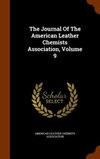Transglutaminase Crosslinked Gelatin Films Extracted from Tanned Leather Waste
IF 0.5
4区 工程技术
Q4 CHEMISTRY, APPLIED
Journal of The American Leather Chemists Association
Pub Date : 2021-01-07
DOI:10.34314/jalca.v116i1.4216
引用次数: 4
Abstract
The production of biodegradable polymers has proved to be a promising alternative, since these materials have accelerated degradation, contributing to the reduction of residues and the reduction of environmental pollution. The tannery wastes contain considerable collagen and can be used for gelatin extraction and film production for use in agriculture. Gelatin-based films, however, present some challenges for practical application, such as permeability and solubility in water, parameters that can be improved through the crosslinking process by employing enzymes, promoting the union of polymeric gelatin chains. In this context, the action of the enzyme transglutaminase was investigated to improve the properties of gelatin films recovered from leather and chitosan residues, which were evaluated according to thickness, solubility, permeability, mechanical properties, and soil degradation. The results indicated that the enzyme concentration in the films had a significant effect on the properties of water permeability and solubility and strain to rupture. The evaluation of soil degradation showed that films with higher enzyme addition took longer to be degraded.从鞣革废料中提取转谷氨酰胺酶交联明胶薄膜
生物可降解聚合物的生产已被证明是一种很有前途的替代方法,因为这些材料可以加速降解,有助于减少残留物和减少环境污染。制革废料中含有大量的胶原蛋白,可用于明胶提取和用于农业的薄膜生产。然而,明胶基薄膜在实际应用中存在一些挑战,例如在水中的渗透性和溶解度,这些参数可以通过酶的交联工艺来改善,促进聚合物明胶链的结合。在此背景下,研究了谷氨酰胺转胺酶的作用,以改善从皮革和壳聚糖残留物中回收的明胶薄膜的性能,并根据其厚度、溶解度、渗透性、力学性能和土壤降解性进行了评价。结果表明,膜中酶的浓度对膜的透水性、溶解度和破裂应变有显著影响。土壤降解评价表明,酶添加量越大,膜的降解时间越长。
本文章由计算机程序翻译,如有差异,请以英文原文为准。
求助全文
约1分钟内获得全文
求助全文
来源期刊

Journal of The American Leather Chemists Association
工程技术-材料科学:纺织
CiteScore
1.30
自引率
33.30%
发文量
29
审稿时长
3 months
期刊介绍:
The Journal of the American Leather Chemists Association publishes manuscripts on all aspects of leather science, engineering, technology, and economics, and will consider related subjects that address concerns of the industry. Examples: hide/skin quality or utilization, leather production methods/equipment, tanning materials/leather chemicals, new and improved leathers, collagen studies, leather by-products, impacts of changes in leather products industries, process efficiency, sustainability, regulatory, safety, environmental, tannery waste management and industry economics.
 求助内容:
求助内容: 应助结果提醒方式:
应助结果提醒方式:


